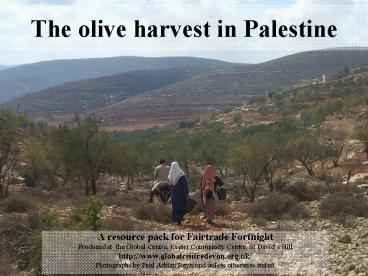The olive harvest in Palestine - PowerPoint PPT Presentation
1 / 10
Title: The olive harvest in Palestine
1
The olive harvest in Palestine
- A resource pack for Fairtrade Fortnight
- Produced at the Global Centre, Exeter Community
Centre, St Davids Hill - http//www.globalcentredevon.org.uk/
- Photographs by Paul Adrian Raymond unless
otherwise stated.
2
1 The olive harvest in Palestine
For thousands of years, farmers in the
Mediterranean have grown olives. These tiny,
bitter fruits are eaten whole or pressed for oil,
which is mainly used for cooking. Most
Palestinians in the West Bank (see map) have a
family olive grove. Tending the trees is a shared
task, and the olive harvest each Autumn involves
the whole family, from schoolchildren to
grandmothers.
In numbers 10 million The number of olive
trees in the Palestinian West Bank, which is
slightly smaller than Devon.
Map www.cia.gov
A Palestinian family harvesting their olives
3
2 Picking the olives
Farmers pick their olives by hand or hit the
branches of the trees with sticks to loosen the
fruit. The olives collect on the tarpaulins
spread across on the ground.
Some olive trees are ancient. This one is thought
to be 2,000 years old, but it still produces
fruit!
4
The crop of olives can look very small, because
olives are tiny fruits. In a whole season, a
Palestinian family might only pick five or six
sacks of olives. But Palestinian olive oil is
very good quality and even a few bottles can be
worth a lot of money.
3 Gathering the harvest
When a trees olives have all been picked, the
farmers sort what is on the tarpaulins and throw
away the leaves and twigs. Then they gather the
olives into sacks to be taken to the nearest town
and pressed for oil.
5
The olive press is where the oil is extracted
from the olives and collected so it can be used.
4 - At the olive press
First, the olives are tipped into the collection
point
then a conveyor belt picks the olives up and
drops them into a machine that washes them
while a furnace in the corner is used to boil up
some water.
6
5 Extracting the oil
The pulp is then piped through into these
machines, which separate the oil from the solids.
The olives are crushed up in this machine and
mixed with hot water. This forms a thick pulp,
like olive-flavoured porridge.
7
At the end of the production line, the fresh,
bitter olive oil flows out into an old (clean!)
bathtub.
6 Collecting the Oil
Did you know? Olive oil is mostly used in food,
but it can also be made into soap!
It is then piped out through the plug hole and
collected in jerry cans for storage.
8
Nothing the olive tree provides is wasted. The
crushed, dried-out remains of the olive skins and
seeds come out of another part of the press as a
brown powder called jiffit. It is collected in
sacks and spread out to dry in the sun. Jiffit
contains leftover olive oil and is a very rich
fuel. People burn it in stoves to heat their
houses in winter. When the olive trees are pruned
following the harvest season, the branches are
collected and given to the sheep, which eat the
leaves. The wood can then be burned as fuel.
7 Making use of the leftovers
9
8 The problem of politics
Sadly, Palestinian farmers are not always able to
pick their olives. Palestinians have been at war
with Israel for decades, and Israelis with
machine guns and dogs often attack them and
prevent them from reaching their trees. Some
trees near Israeli houses are off limits
entirely, while others can only be reached once a
year at harvest time. But without the constant
care and attention that olive trees need, the
crop from these trees is very small. (Photo Simi
Ann Solaas)
10
but the process of olive harvesting continues,
much as it has for thousands of years. The End

